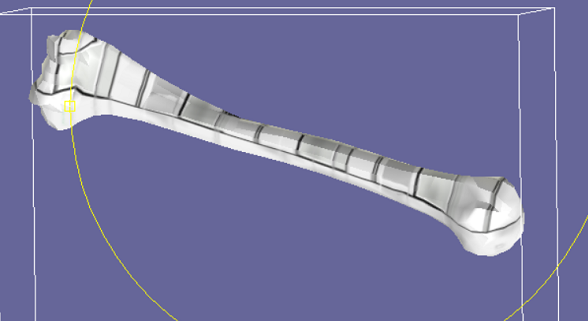BY LETTER
Compubones
Technology > Application > Augmentics
Technology > Technology Levels > High Tech / Hitech
Technology > Technology Type or Material > Nanotech
Technology > Technology Type or Material > Organic/Biotech
Technology > Technology Levels > High Tech / Hitech
Technology > Technology Type or Material > Nanotech
Technology > Technology Type or Material > Organic/Biotech
Biotech computing using bone tissue |
 Image from Steve Bowers |
Also known as memorybone, hydroxy-processors and nanobone. A bionanotech process whereby portions of a subject's skeleton are converted into bioprocessors, which draw energy and nourishment from the subject's blood supply (just like the rest of their organs). These alterations avoid the bone marrow, so there is no effect on the subject's blood supply, instead taking place in the 'dead' parts of the bone. The altered bones will either be as physically strong as the bone they replace, or the rest of the bone will be reinforced to maintain skeletal strength. The creature whose skeleton is converted to compubones does not have to be a sophont.
The compubone modification often also includes other augmentations, such as stronger bones, faster healing and so on. Biologically-grown carbon nanotube or other diamondoid materials may be incorporated into the tissue, for instance.
Compubones are limited in their capability by two things. First, they have a rather variable signalling time, depending on where in the body a given processor, communicating with another processor, is. This is, however, static once the compubones are in place, and so can be compensated for.
A more serious problem is the heat generated, even with reversible computing, by a high density of processing, which can, at high levels, cook the flesh around the compubones unless further modifications to dissipate it are made (the same sort of modifications as are already in place for biological superbrights). A sophont making extensive use of compubone processing may require larger ears or other heat radiating surfaces, making them look significantly different from other clades. Because of this, compubones in otherwise unmodified creatures tend to be limited in either or both of two ways. Firstly, the compubone may be used largely as memory storage. Long-lived individuals - and there are a great many of these in Terragens space - use this in particular, to overcome some of the limitations of a biological brain. Secondly, compubone processing is limited to speeds that generate relatively little heat, certainly a low enough level for the human body to handle; for highly intensive computing needs the compubones link to external processors (either worn on the person or located in the immediate environment) with the intensive processing then done outside the body of the person with the results returned back to the person once the job was done.
In general compubones will be used to enhance the intellect of the person (or other creature) whose skeleton they are part of, usually enough to, if the person wishes, take them up one toposophic level, although in this case additional modifications to dissipate the heat generated by the high density of processing required is needed. Compubones can also be used to create animals which can download and store data as a form of mobile library, or which have a great deal of extra intelligence or task-specific processing (useful for, for example, enhanced guard beasts).
Compubones also requires the subject to consume considerably more calories per day to power them. Most compubones installations have safety features to ensure they do not cause the person they are in to starve should food become scarce for some reason, but there have been instances of compubones starving a person to death.
There are known cases of people's skeletons being turned into compubones secretly, for various reasons, ranging from espionage to providing a virch world for a small Hider community. Validating compubones symbiotes to ensure that they are what they appear to be is a non-trivial factor in their installation in many polities.
Appears in Topics
Development Notes
Text by Tony Jones
Initially published on 16 August 2003.
Initially published on 16 August 2003.






